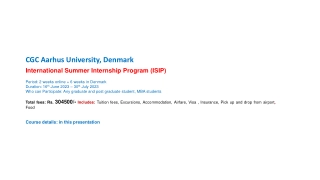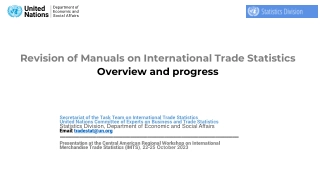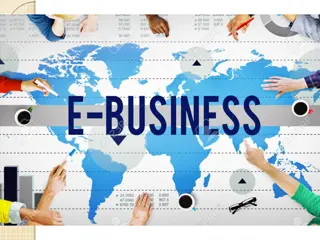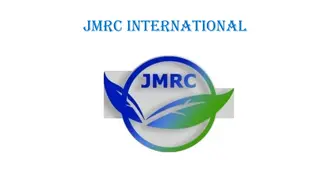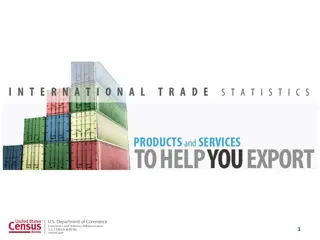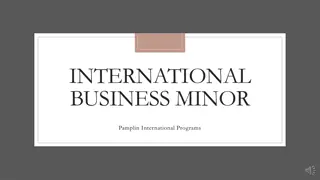
Understanding International Business Basics
Explore the fundamentals of international business, including reasons for conducting business across borders, concepts like absolute and comparative advantage, and the key principles of importing and exporting. Learn about the objectives, barriers, and regulations of engaging in international trade.
Download Presentation

Please find below an Image/Link to download the presentation.
The content on the website is provided AS IS for your information and personal use only. It may not be sold, licensed, or shared on other websites without obtaining consent from the author. If you encounter any issues during the download, it is possible that the publisher has removed the file from their server.
You are allowed to download the files provided on this website for personal or commercial use, subject to the condition that they are used lawfully. All files are the property of their respective owners.
The content on the website is provided AS IS for your information and personal use only. It may not be sold, licensed, or shared on other websites without obtaining consent from the author.
E N D
Presentation Transcript
INTERNATIONAL BUSINESS Chapter-6
International Business: Doing business activities with another country. Business (Buying and Selling) International business (Importing and Exporting)
Objectives of the Chapter 1.Why firms conduct International Business 2.Basic Concepts of International Business 3.Barriers to International Business 4.Regulation of International Business 5.Approaches to International Business 6.Adapting to Foreign Markets
Why Firms (Country) Conduct International Business? International business activities across national boundaries. E.g. Coca-cola, Microsoft, Toyota, etc. A country with a surplus of some product may decide to sell this surplus to other nations. Such sales will enable the country to purchase other products that it may not have the ability to produce. Scarcity of resources is perhaps the major reason why nations trade with each other. Business (IB): The performance of
Absolute Advantage When a country can produce a product on the basis of its geographic location or natural resources then it is called absolute advantage. E.g. South advantage in the production of Diamonds. Other examples might include oil for Saudi Arab, tea leafs, Hilsha Fish, Shrimp for Bangladesh Africa has an absolute
Comparative Advantage When a country can produce one product more efficiently (Less resources time, money, raw materials) and at a lower cost than other products, in comparison than other nations. E.g. Countries with low labor costs, such as readymade garment products for Bangladesh. Bangladesh placed itself in top five exporters of ready made garment products in the world due to this comparative advantage.
Five Basic Concepts of International Business 1. Importing: Buying foreign made goods from another country is called importing. 2. Exporting: Businesses that sell their domestic made goods and services to other countries 3. Balance of trade (BOT) is the difference between the value of a country's imports and exports for a given period. Fiscal Year 1 July 2021 to 30 june, 2022 Export amount: $150 Million Import amount: $210 Million BOT amount: $60 Million (Unfavorable/negative BOT)
Five Basic Concepts of International Business 4. Balance of Payment: The balance of payments (BOP) is the difference between total cash inflow and cash outflow of a country in a given period. BOP covers all types of transactions such as, importing, exporting, outward remittance, inward remittance, foreign investments, foreign aid etc. Example (BD): Cash Inflow: $100 million (inward remittance), $150 million (export), $60 million (foreign aid and investment)= $310 million Cash outflow: $210 million (import), $30 million (outward remittance) = $240 million 5. Exchange Rate: An exchange rate is the value of a country's currency vs. that of another country or economic zone. Most exchange rates are free- floating and will rise or fall based on supply and demand in the market
Barriers to International Business 1. Cultural and Social Barriers 2. Political Barriers 3. Tariffs and Trade Restrictions: a) Import Tariff: A duty or tax charged against goods brought into a country (tax on automobile, car, bike etc) b) Quota: A limit on the amount of a product that can leave or enter a country c) Embargo: A total ban on certain imports and Exports. (pork meat, skin of certain animals)
Cultural and Social Barriers: Due to the difference in preference or acceptance of certain products, international business faces a lot of challenges. For example, religious barriers. Alcohol is prohibited in most of the Muslim countries. Therefore, exporting alcohol products in those countries are prohibited. (another example: pork meats)
Approaches to International Business 1. Exporting 2. Licensing: Licensing is another way to enter a foreign market with a limited degree of risk. Under international Licensing, a firm in one country permits a firm in another country to use its intellectual property( Patents, trade marks etc). 3. Franchising Franchising is a business model in which many different owners share a single brand name.
Approaches to International Business 3. Joint Venture: A joint venture is a business arrangement in which two or more parties agree to pool their resources for the purpose of accomplishing a specific task. This task can be a new project or any other business activity. However, the venture is its own entity, separate from the participants' other business interests 4. Acquisition: An acquisition is when one company purchases most or all of another company's shares to gain control of that company.
Approaches to International Business 5. Trading Companies: Trading companies are specialists that cover all export and import operations and procedures. A trading company buy products in one country and sold them in different countries where it has its own distribution network. 6. Countertrading refers to when an exporter agrees to accept payment in the form of goods or services. There are many forms of countertrading, ranging from simple barter agreements to complex offset deals. Countertrading commonly takes place between private companies in developed nations and the governments of developing countries.

